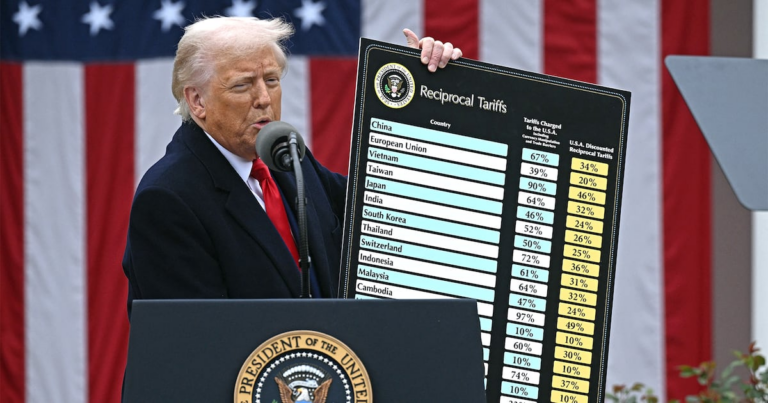The global fashion industry was stunned Wednesday after President Donald Trump announced the best and most comprehensive tariffs in nearly a century.
At the address of the White House Rose Garden, Trump announced a baseline tariff of 10% on all imports. However, tariffs are set significantly higher in around 20 countries where the US has a trade deficit, with many of the fashion industry’s largest production centers.
Goods from Vietnam – The second largest apparel exporter after China will be exported to the US, subject to 46% tariffs, Cambodia has a 49% obligation, and Bangladesh has a 37%. China will be subject to a new 34% tariff in addition to its previously announced duties, raising the tariff rate to 54%, and the EU will be hit with a 20% duty.
“We are deeply disappointed by the Trump administration’s decision to impose new tariffs on all imports,” the American Fashion Industry Association, a trade group, said in a statement. “This action will particularly affect American fashion brands and retailers.”

Trump said tariffs will take effect in the middle of the night.
Fashion inventory quickly fell sharply in trading outside of business hours, with Lululemon’s stock down more than 10%, with Nike and Ralph Lauren down 7%, and Tapestry, Capri and Pvh Corp. down about 5%. This decline exceeded nearly 4% DIP on S&P 500 futures.

New obligations following Trump’s previous tariffs on goods from China, Mexico and Canada are set to raise costs and cause disruption to countless fashion businesses. The US is one of the world’s largest consumers of apparel and footwear, and has become a very important market for both the US and international companies. As the US imports more than 98% of its clothing and around 99% of its shoes, almost every fashion item sold in the country is struck by additional missions.
With his announcement, Trump held a large chart showing countries his administration directly targeted at different tariff rates. The rate was higher than many analysts expected.
“We open up foreign markets to break the barriers to foreign trade, and ultimately increase production at home means competition for consumers and lower prices,” the US president said in his speech. “In fact, this will be America’s golden age. It’s coming back. We’ll be coming back very strongly.”
Shocks could echo across the fashion supply chain. After Trump’s previous tariff announcement, companies such as Walmart had already announced their intention to negotiate with suppliers and ask them to cut costs to take on some of the burden. Factory already tends to operate at slim margins, and the demand for price reductions only narrows them down further. As everyone wants low prices to save money, the effect can cause the chain to ruffle for textile manufacturers and farmers.
Meanwhile, many brands and retailers need to choose whether to absorb costs in order to stabilize prices or pass them to customers via price hikes, at the moment when many are already tired of inflation and keep their budgets in mind. Before the new tariffs were announced, uncertainty about what Trump’s plans would entail had already hampered the confidence of American consumers.
“More tariffs rival more anxiety and uncertainty for American businesses and consumers,” said David French, vice president of government relations for the National Federation of Retail, in a statement after the release.

Tariffs clash with a variety of fashion businesses, but at this point some sectors may be particularly vulnerable. Luxury, for example, considers the US to be the most resilient market for the global slowdown. However, there are few companies that produce products within the borders. This means that after raising prices for most of the past few years, new costs have started to come in. LVMH, which opened its third factory in the US in 2019, is one of the few with a remarkable manufacturing footprint in the country. In a recent research note, Piral Dadhania, an analyst at RBC Capital Markets, estimated that these facilities account for about 50% of US product volume.
Before the tariff announcement, Dadania had estimated the impact of many gorgeous names on net profits, assuming a 20% blanket tariff. This estimate did not take into account the possibility of even higher numbers, such as the Swiss 31% rate. Higher prices and flagging sentiments may not stop the spending of ultra-rich people, but they could undermine the so-called ambitious shopper atmosphere that has already shown that demand for luxury goods has been reduced in recent years amid rising prices.

Sports brands are also on the shooting line. Many have led accusations in diversifying procurement from China, which was subject to tariffs during Trump’s first term. However, they often move to countries such as Vietnam and Cambodia, facing a surge in costs. For example, Nike made 50% of its footwear in Vietnam in 2024, while the Swiss running brand photographed 90% of its shoes.
But all fashion businesses feel that in some way it works. Even people who produce finished products in the US get a lot of the raw materials from overseas. The industry will need to navigate a new set of challenges over the coming months.
Download the latest information for more information on the impact of tariffs and how the fashion industry can handle it Executive Note: Action Plans to Navigate Trump’s Tariffsonly available to executive members.


